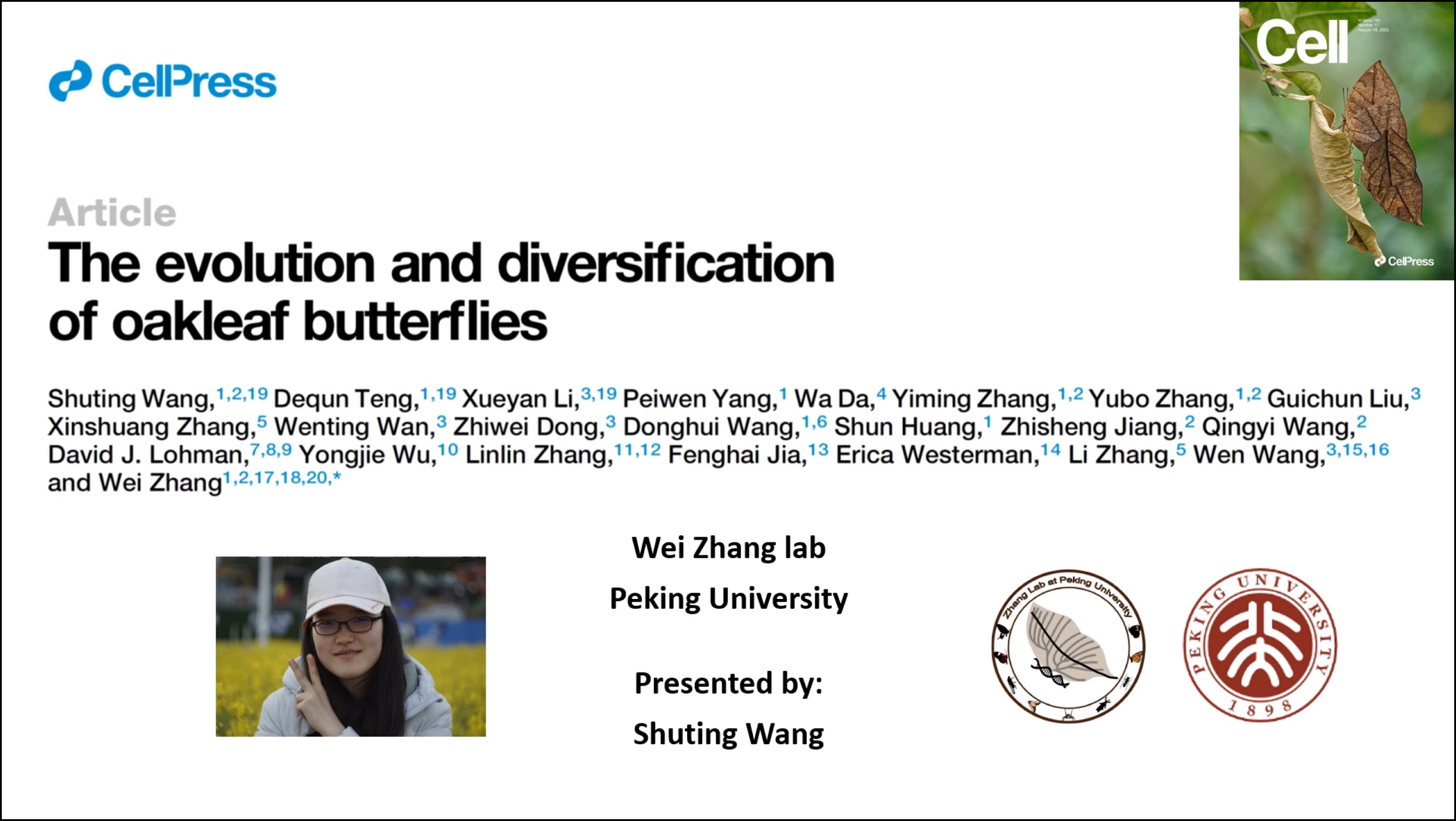The evolution and diversification of oakleaf butterflies
Shuting Wang1, Dequn Teng2, Xueyan Li3, Peiwen Yang2, Wa Da4, Yiming Zhang1, Yubo Zhang1, Guichun Liu3, Xinshuang Zhang5, Wenting Wan3, Zhiwei Dong3, Donghui Wang6, Shun Huang2, Zhisheng Jiang7, Qingyi Wang7, David J Lohman8, Yongjie Wu9, Linlin Zhang10, Fenghai Jia11, Erica Westerman12, Li Zhang5, Wen Wang13, Wei Zhang14
- State Key Laboratory of Protein and Plant Gene Research, School of Life Sciences, Peking University, Beijing 100871, China; Peking-Tsinghua Center for Life Sciences, Academy for Advanced Interdisciplinary Studies, Peking University, Beijing 100871, China.
- State Key Laboratory of Protein and Plant Gene Research, School of Life Sciences, Peking University, Beijing 100871, China.
- State Key Laboratory of Genetic Resources and Evolution, Kunming Institute of Zoology, Chinese Academy of Sciences, Kunming 650223, China.
- Tibet Plateau Institute of Biology, Lhasa, Tibet 850001, China.
- Chinese Institute for Brain Research, Beijing 100871, China.
- State Key Laboratory of Protein and Plant Gene Research, School of Life Sciences, Peking University, Beijing 100871, China; National Teaching Center for Experimental Biology, Peking University, Beijing 100871, China.
- Peking-Tsinghua Center for Life Sciences, Academy for Advanced Interdisciplinary Studies, Peking University, Beijing 100871, China.
- Biology Department, City College of New York, City University of New York, New York, NY 10031, USA; Ph.D. Program in Biology, Graduate Center, City University of New York, New York, NY 10016, USA; Entomology Section, National Museum of Natural History, Manila 1000, Philippines.
- Key Laboratory of Bio-Resources and Eco-Environment of Ministry of Education, College of Life Sciences, Sichuan University, Chengdu 610065, China.
- CAS and Shandong Province Key Laboratory of Experimental Marine Biology, Center for Ocean Mega-Science, Institute of Oceanology, Chinese Academy of Sciences, Qingdao 266071, China; Laboratory for Marine Biology and Biotechnology, Qingdao National Laboratory for Marine Science and Technology, Qingdao 266071, China.
- Jiangxi University of Traditional Chinese Medicine, Nanchang 330004, China.
- Department of Biological Sciences, University of Arkansas, Fayetteville, AR 72701, USA.
- State Key Laboratory of Genetic Resources and Evolution, Kunming Institute of Zoology, Chinese Academy of Sciences, Kunming 650223, China; School of Ecology and Environment, Northwestern Polytechnical University, Xi'an 710072, China; Center for Excellence in Animal Evolution and Genetics, Kunming 650223, China.
- State Key Laboratory of Protein and Plant Gene Research, School of Life Sciences, Peking University, Beijing 100871, China; Peking-Tsinghua Center for Life Sciences, Academy for Advanced Interdisciplinary Studies, Peking University, Beijing 100871, China; Institute of Ecology, Peking University, Beijing 100871, China; Institute for Tibetan Plateau Research, Peking University, Beijing 100871, China. Electronic address: weizhangvv@pku.edu.cn.
Abstract
Oakleaf butterflies in the genus Kallima have a polymorphic wing phenotype, enabling these insects to masquerade as dead leaves. This iconic example of protective resemblance provides an interesting evolutionary paradigm that can be employed to study biodiversity. We integrated multi-omic data analyses and functional validation to infer the evolutionary history of Kallima species and investigate the genetic basis of their variable leaf wing patterns. We find that Kallima butterflies diversified in the eastern Himalayas and dispersed to East and Southeast Asia. Moreover, we find that leaf wing polymorphism is controlled by the wing patterning gene cortex, which has been maintained in Kallima by long-term balancing selection. Our results provide macroevolutionary and microevolutionary insights into a model species originating from a mountain ecosystem.
Presented By Shuting Wang

